Plasterboard
Plasterboard is considered to be a large component of New Zealand’s construction and demolition waste stream. There is currently no plasterboard recycling occurring in NZ although Winstone Wallboards (the sole manufacturer of plasterboard in NZ) has carried out research into the potential of recycling plasterboard and supported this project since 2005.
Issues affecting plasterboard recycling are contamination in recovered plaster board, different chemical compositions from imported plasterboards and the difficulty of sorting different plasterboard types. According to Ministry for the Environment guidelines, plasterboard is not allowed in cleanfills due to leachate and off gassing caused during the decomposition process.
Plasterboard student work
- Jayden Thompson - Reuse of Waste Plasterboard - Winstone Wallboards Prize 2010
- Eric Bliss - Flood Prevention and Remediation 2010
- Libby Elmore - 'Vacuum Insulation Panels' Winstone Wallboards Prize 2009
- Hamish McPhail - 'Woolmatt' 2009
- Phillip Cook - 'Giblets' Winstone Wallboards Prize 2008
- James Bremner - Tiling Grout Winstone Wallboards Prize 2007
- Logan Brown - 'Eco Brick' - gypsum and fly ash bricks WasteMINZ prize 2007
- Rebekah Nancekivell - Planter – Winstone Wallboards Top Prize 2005
- James Dinsdale – Composting System – Winstone Wallboards Prize 2005
- Karina Madsen – Laminated Bricks – Winstone Wallboard Prize 2005
- Charlotte Bowie – Adobe Reinforcement – WasteMINZ prize 2005
- Kuan Lu - Artificial Pumice Insulation 2005
- Stephanie Livick ‘Gibrix’ - Thermal Mass Blocks – WasteMINZ Prize Winner 2003
- Matthew Mitchell – Bedding Compound - Highly Commended 2003
Jayden Thompson - Reuse of Waste Plasterboard - Winstone Wallboards Prize 2010
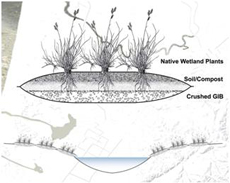
Jayden, a landscape architecture student was awarded this prize for his gypsum and soil filled sacks that can be used to remediate stream sides damaged by stock grazing. His research indicates that using waste gypsum in this way will help to break down the compacted clay on the stream banks. This helps the banks but also the plants planted within the sacks to take hold as the sacks biodegrade, further preventing erosion. The slow release of the gypsum into the damaged waterways also may help the water way to remain clear, thus enhancing water plant growth and habitat. The sacks also keep the cows off the affected areas and provide habitat for riparian creatures.
Eric Bliss - Flood Prevention and Remediation 2010
Eric found that by substituting recalcinated gypsum for the sand used in sandbags he could create a flood prevention system which outperformed traditional sandbags. By using gypsum, the bags could support plant growth over time, further strengthening or remediating river banks. The gypsum will actually set underwater. As the gypsum is slowly released into waterways during flood events it also acts as a flocculent, clarifying the water more quickly.
Libby Elmore - 'Vacuum Insulation Panels' Winstone Wallboards Prize 2009
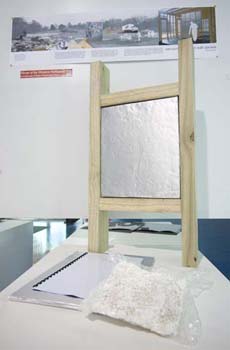
Libby, an architecture student created a new insulation product using excess building materials from construction sites by taking research into vacuum insulation panels (VIP’s) into account.
The core of the panels is made from waste crushed gib board along with chipped timber off-cuts and polystyrene.
R values are in the range of 30 to 50, so heating energy demand is greatly reduced, health benefits accrue and construction waste is reduced to landfill while being reutilised within the construction industry.
Hamish McPhail - 'Woolmatt' 2009
Hamish designed 'Woolmatt' to be a natural alternative to synthetic weed mats or water filtration systems used in agricultural, road building, drainage and landscaping applications. 'Woolmatt' is made from a combination of waste wool/dags and gypsum from waste plasterboard. It acts as a soil conditioner and water cleansing mechanism once in place, improving soil fertility, soil aeration, and adding organic matter resulting in more humus in soil. Hamish has gone on to develop this idea as part of Wellington City Council's Bright Ideas Challenge.
Phillip Cook - 'Giblets' Winstone Wallboards Prize 2008
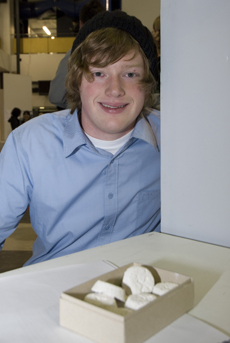
Phillip Cook, an architecture student was awarded this prize for his gypsum wetland growth enchancing pellets which he named 'giblets'.
His research indicates that using waste gypsum in this way may help water in wetlands to remain clear, thus enhancing plant growth.
Such a system was also thought to be useful in reducing natural methane emission from wetlands.
James Bremner - Tiling Grout Winstone Wallboards Prize 2007
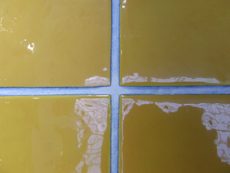
Winstone Wallboards offered a prize to an innovative project utlising plasterboard. James Bremner, a design student was awarded this prize for his tiling grout made of 100% waste plasterboard.
Logan Brown - 'Eco Brick' - gypsum and fly ash bricks WasteMINZ prize 2007
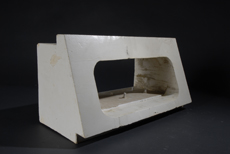
Logan Brown, an architecture student designed an 'Eco Brick' made of waste plasterboard and fly ash (a by product of coal power plants such as Huntly power station). The brick was designed to form a wall that by using the properties of gypsum as a soil conditioner and its ability to break down clay soils, would encourage and nurture plants to colonise the wall.
Rebekah Nancekivell - Planter Winstone Wallboards Top Prize 2005
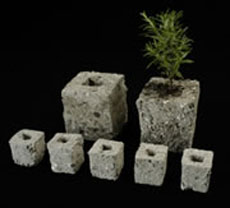
Rebekah Nancekivell, an architecture student, won the overall prize. She designed a series of planters for seedlings made from a mixture of earth, compost and crushed gypsum waste. They are to be planted directly into the ground where they then biodegrade. Because of gypsum’s unique ability to assist in the breakdown of clay bound soils, these planters not only find a novel use for waste but allow for soil enrichment and provide an environment where plants can take root in the compost rich planters as they decompose in the more hostile local clay soils.
James Dinsdale - Composting System Winstone Wallboards Prize 2005
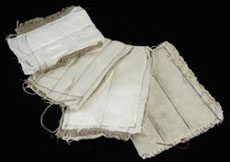
James Dinsdale, an industrial design student, also took the soil enhancing benefits of gypsum into account when he designed ‘Eco Bin’ a compost bin system made from crushed gypsum waste sandwiched between layers of fabric. The idea behind the product was that people would buy packs of the gypsum encrusted fabric, form them into any shape they needed and then wet the fabric down whereby it would harden into usable bins. The gypsum bins enrich the compost as they start to decompose. This flexible, ‘wet to harden’ system was thought to have great potential as easily transportable and buildable shelters in disaster relief operations. James won one of the Winstone Wallboard prizes.
Karina Madsen - Laminated Bricks Winstone Wallboard Prize 2005
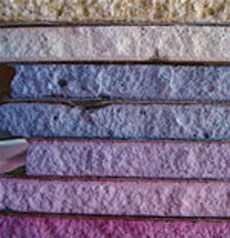

Karina Madsen, an environmental science student, also won a Winstone Wallboard Prize. Her idea was to take waste plaster board off cuts and make laminated bricks. These form interior wall or ceiling systems that have good acoustic properties and high thermal mass (they are able to store the heat of the sun and re-radiate it). She also experimented with the absorptive qualities of gypsum to soak up colour from natural dyes. The resource conservation potential of this simple solution was thought to be extensive, as sorting of off cuts and reprocessing of the waste is minimized.
Charlotte Bowie – Adobe Reinforcement WasteMINZ prize 2005
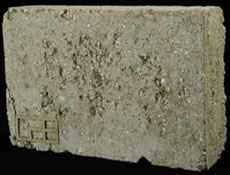
Charlotte Bowie, an industrial design student, was the recipient of the WasteMINZ best report prize where she thoroughly documented her project looking into the addition of waste plaster board to adobe earth bricks to increase their strength.
Kuan Lu - Artificial Pumice Insulation 2005
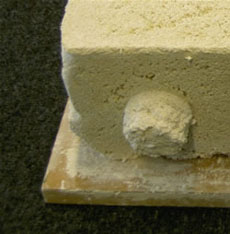
After a series of experiments the student was able to find a method for capturing air pockets in reconstituted plaster board waste as it resets. The resulting product looked and behaved in a similar way to natural pumice and is intended to be used as a recycled alternative to pumice for insulation purposes.
Stephanie Livick ‘Gibrix’ - Waste Plasterboard WasteMINZ Prize Winner 2003
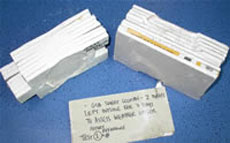
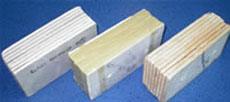
‘Gibrix’ is a building block constructed from plasterboard off-cuts intended for use in internal walls. The blocks are designed to fit into each other easy and quickly and fit into standard wooden framing. The major benefits of ‘Gibrix’ are that any kind of waste plasterboard can be used in the product, reducing the complexity of the sorting process. Manufacturing processes would be simple and the resulting blocks have high thermal mass and have some acoustic insulation properties also. Blocks are intended to be plastered over or simply left exposed, coated with a clear breathable coating to prevent dust problems.
Matthew Mitchell - Waste Plasterboard Highly Commended 2003
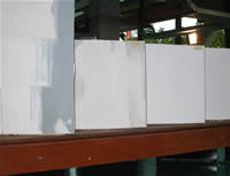
Plasterboard waste was sourced from construction sites and re-calcined to make an easy to produce and use bedding compound for plastering joints of plasterboard walls. It was estimated that almost a third of the plasterboard waste stream could be diverted by recycling the waste into such a bedding compound.
